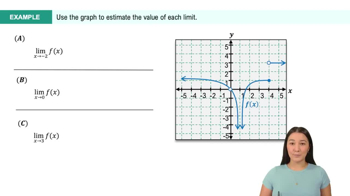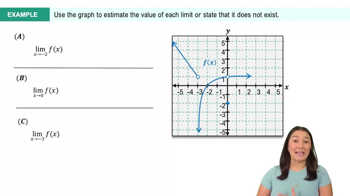Table of contents
- 0. Functions7h 52m
- Introduction to Functions16m
- Piecewise Functions10m
- Properties of Functions9m
- Common Functions1h 8m
- Transformations5m
- Combining Functions27m
- Exponent rules32m
- Exponential Functions28m
- Logarithmic Functions24m
- Properties of Logarithms34m
- Exponential & Logarithmic Equations35m
- Introduction to Trigonometric Functions38m
- Graphs of Trigonometric Functions44m
- Trigonometric Identities47m
- Inverse Trigonometric Functions48m
- 1. Limits and Continuity2h 2m
- 2. Intro to Derivatives1h 33m
- 3. Techniques of Differentiation3h 18m
- 4. Applications of Derivatives2h 38m
- 5. Graphical Applications of Derivatives6h 2m
- 6. Derivatives of Inverse, Exponential, & Logarithmic Functions2h 37m
- 7. Antiderivatives & Indefinite Integrals1h 26m
1. Limits and Continuity
Introduction to Limits
Problem 2.5.66
Textbook Question
If a function f represents a system that varies in time, the existence of lim t→∞limf(t) means that the system reaches a steady state (or equilibrium). For the following systems, determine whether a steady state exists and give the steady-state value.
The population of a culture of tumor cells is given by .
 Verified step by step guidance
Verified step by step guidance1
First, identify the function given: \( p(t) = \frac{3500t}{t+1} \). This function represents the population of tumor cells over time.
To determine if a steady state exists, we need to evaluate the limit of \( p(t) \) as \( t \) approaches infinity: \( \lim_{t \to \infty} \frac{3500t}{t+1} \).
Simplify the expression by dividing the numerator and the denominator by \( t \), the highest power of \( t \) in the denominator: \( \frac{3500t/t}{(t+1)/t} = \frac{3500}{1 + 1/t} \).
As \( t \to \infty \), the term \( 1/t \) approaches 0. Therefore, the expression simplifies to \( \frac{3500}{1 + 0} = 3500 \).
Conclude that the limit exists and the steady-state value of the population is 3500. This means the population of tumor cells approaches 3500 as time goes to infinity, indicating a steady state.
Recommended similar problem, with video answer:
 Verified Solution
Verified SolutionThis video solution was recommended by our tutors as helpful for the problem above
Video duration:
2mPlay a video:
Was this helpful?

 6:47m
6:47mWatch next
Master Finding Limits Numerically and Graphically with a bite sized video explanation from Callie
Start learning





